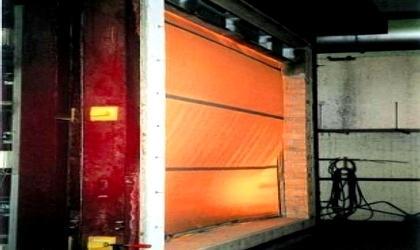When it comes to fire safety measures, fire curtains offer more flexibility than heavier fire shutters, allowing spaces to stay open while still having a fire protection option if needed.
However, if you install a fire curtain as an alternative to other systems, it’s essential to make sure that it’s in working order at all times through regular testing and maintenance.
If you aren’t sure what the legal requirements for fire curtain testing are, this blog explains what you need to know about fire curtain maintenance and what to do if your fire curtains need servicing.
What are fire curtains?
A fire curtain is a fire-resistant barrier that’s designed to contain smoke and flames in a fire. Unlike a rigid steel fire shutter, this textile barrier is made from flexible woven fibreglass.
Fire curtains do have metal guide channels and headboxes, allowing them to be rolled up out of the way when not in use, and to slide smoothly into place when activated.
Upon receiving a signal from the connected fire alarm system, the fire curtain will descend to the floor. This seals off the opening, preventing smoke and flames from travelling through. Even if there is no power to the curtain, there should be a gravity fail-safe that allows it to deploy at a steady speed under its own weight.
Fire curtains are most often used in open-plan areas that need to be compartmentalised if a fire breaks out. Where there isn’t a traditional door or wall, a fire curtain can close off the area that the fire is in and allow people to continue using corridors, stairways, and lobbies as escape routes.
While a fire shutter must be fitted into surrounding masonry or structural steel, it’s possible to install a fire curtain in many more places throughout a building.
According to government legislation, fire curtains are classified as machinery that requires testing to BS EN 16034:2014 and manufacturing/CE marking to BS EN 13241-1:2014 + A1:2018 standards. Any product tested to the previous 2008 standards is no longer valid.
Why do fire curtains need servicing?
Fire curtains are a critical component of any fire safety strategy that includes them. If they fail to deploy in an emergency situation, this compromises the fire-engineered solution and puts the building and everyone in it in danger.
If you’re the owner of a building with fire curtains, it’s your responsibility to make sure they’re regularly serviced and kept in working condition at all times. The Regulatory Reform (Fire Safety) Order 2005 specifies that you must maintain the curtain’s operational state according to the manufacturer’s instructions – and you could face fines or imprisonment if you don’t.
You’ll need to follow BS 8524-1 for the design, testing, and classification requirements of fire curtain assemblies, and BS 8524-2 for their installation recommendations and code of practice. These regulations require frequent planned inspections and testing by a ‘competent person’.
While your overall fire safety system requires much more frequent testing, your fire curtains specifically only need to be closely inspected by a qualified engineer 1-2 times a year.
What does fire curtain testing involve?
Maintenance is crucial for any machinery that can contain a fire, as it needs to deliver the same performance as it did at the testing stage for the rest of its lifetime.
There are some smaller checks that a ’responsible person’ onsite can carry out themselves at least once every month, such as:
- Checking for obstructions to the curtain dropping
- Deploying the fire curtain as a test
- Visually inspecting the curtain material
- Monitoring changes to the building’s layout
All checks and tests should be logged to create an accurate record of fire curtain maintenance.
Then, under the requirements to have a minimum of one professional service a year, you should hire a qualified ‘competent’ engineer to:
- Open and close the curtain by all means of activation
- Check the speed of operation and full closure capability
- Inspect the surface for holes, tears, or other fabric damage
- Ensure that all pieces are intact and secured in place
- Check that the side guide channels are level and plumb
- Verify that no unauthorised modifications have been made
The expert engineers can make sure that everything from the fixings and mechanical parts to connected electrical systems like fire alarms and smoke control are all working as they should.
While an annual inspection is recommended for smaller premises, it’s better to have your fire curtains professionally tested at least once every 6 months for larger spaces.
Do you need fire curtain maintenance?
Fire curtains can last over a decade without degrading when they’re properly maintained. If you’re the owner/occupier of a building with fire curtains, it’s up to you to make sure that these products are tested and serviced to the appropriate legal standards.
The more frequently you perform fire tests, the more likely it is that any issues can be found quickly, giving you the opportunity to repair the curtain before it can fail during a real emergency.
This also means that you can call out your fire curtain provider for repair work as soon as it’s needed. They can then check how the machinery is holding up at the next annual or bi-annual maintenance service, minimising the risk of further problems.
The best way to arrange regular fire curtain testing is to set up an ongoing contract with a provider in the area – such as roller shutters in Liverpool – that has the know-how and 24/7 availability to assist with your fire curtains whenever you might need tests or repairs.

































